Making Kringle
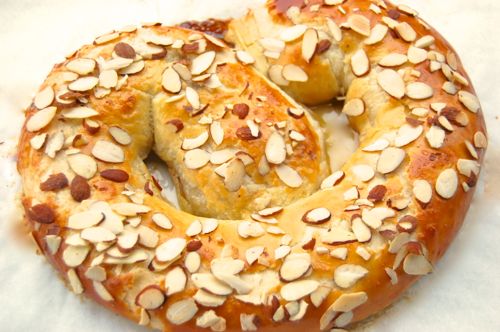
Like a lot of sort-of laminated pastries, it’s hard to put your finger on just what it is that makes kringle so delicious. It’s not a croissant. It’s not a coffee cake. You think: it’s sort of like both of them but it has it own special, oh…I don’t know what. Then the plumped raisins and hints of cardamom kick in and well…you’re hooked.
Given the payoff it’s hard to believe you can put one of these together in as little as two hours…mixing to baking. A kringle is a great way to keep up on your laminating skills, or, if you’ve never laminated before, to get your feet wet without the pressure of wasting a lot of expensive butter. You need a mere six ounces to make two of these. Start by sifting the flour into the bowl of a mixer fitted with a beater (paddle). Add the sugar, salt and yeast. Stir it all on low to combine.
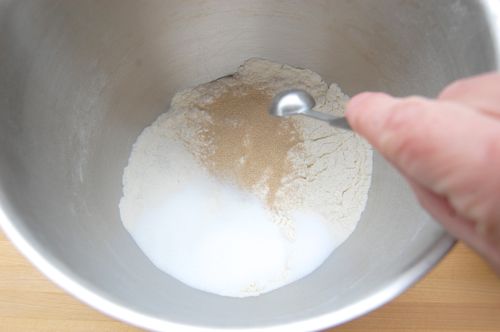
Meanwhile combine the room-temperature egg and milk in a small bowl or cup and give’em a stir.
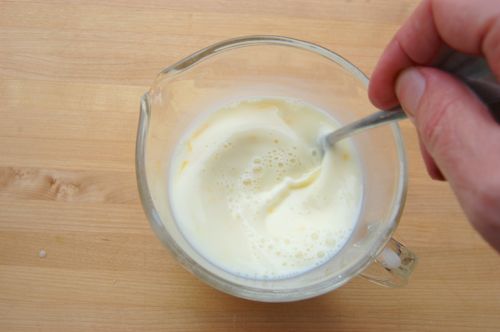
Add one to the other and stir on medium for about 30 seconds.
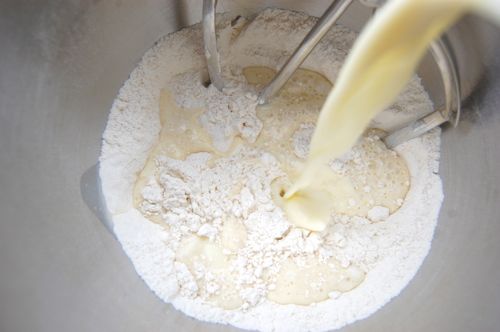
You’ll have the beginnings of a dough. Switch to the hook and turn the machine on medium for about five minutes.
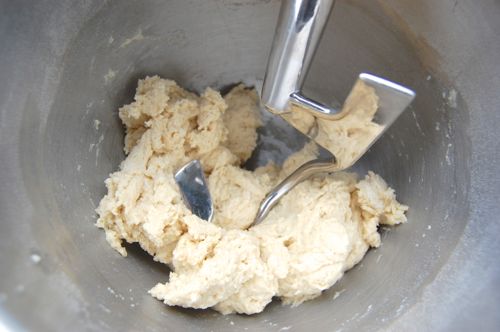
Meanwhile make your butter pat. Make two double layers of plastic wrap. Place the butter on one of them, spoon on about two tablespoons of flour…
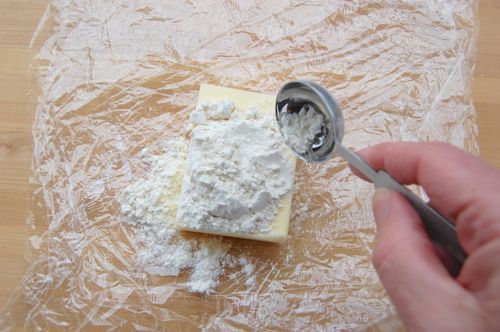
…then apply the other.
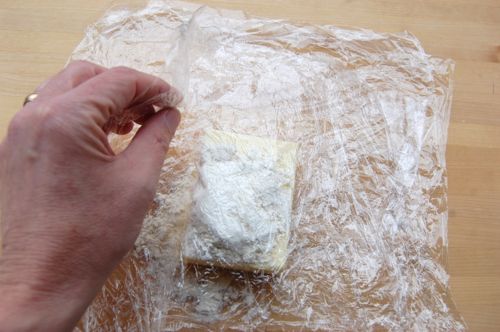
Next, produce your rolling pin and do violence. I like this dowel-shape Chinese pin for the job. I pity the fool who’d try to break into my house while I was laminating dough. It’d be a slaughter. Flour and slivered almonds everywhere.
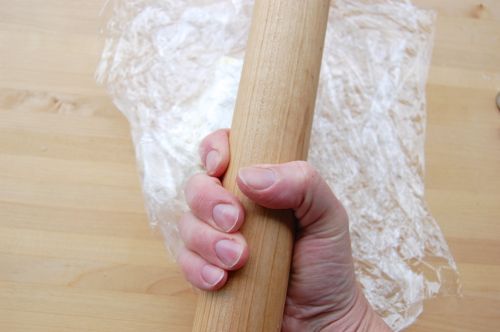
Start by just tapping the butter to get a feel for it…
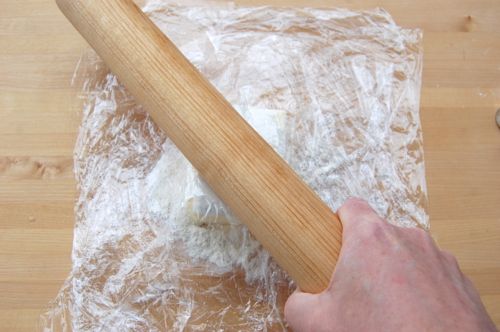
Then begin to hit harder as the butter starts to flatten out. I should say here that most kringle recipes call for blending the flour and butter together in a processor, spreading it out to precise dimensions, refrigerating it, warming it slightly, etc….this is more direct, dirties fewer dishes and above all mirrors the technique for croissant dough, Danish dough and puff pastry. As I mentioned, it’s excellent practice for all of those.
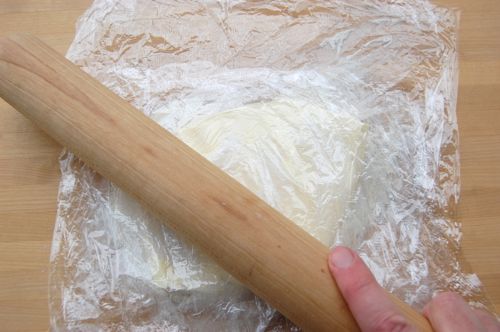
So where was I? Oh yes, when the butter is pretty flat, use a bench scraper or butter knife to cut it into pieces and stack it up again.
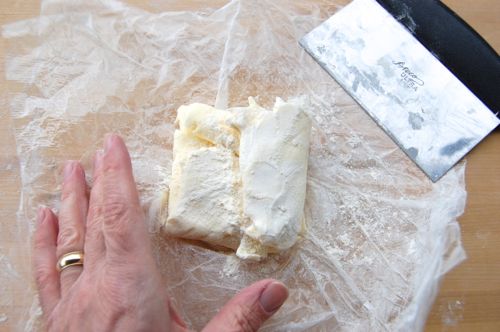
Cover it…
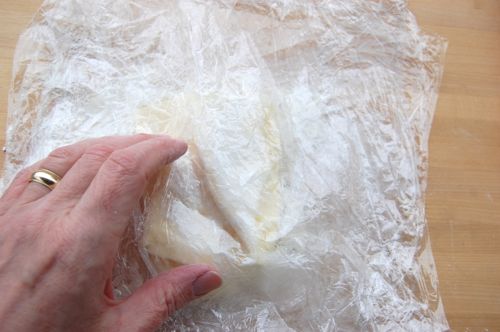
…and repeat the beatings. Repeat this three times and the butter should be about where you want it.
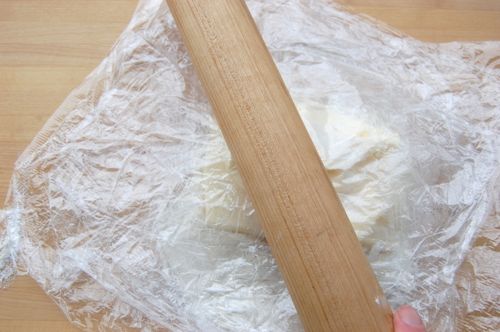
Bam, bam, bam….tap, tap, tap. You can see I broke my first piece of plastic wrap. What happens when that happens? You make another one. See here that most of the flour has been worked in at this point.
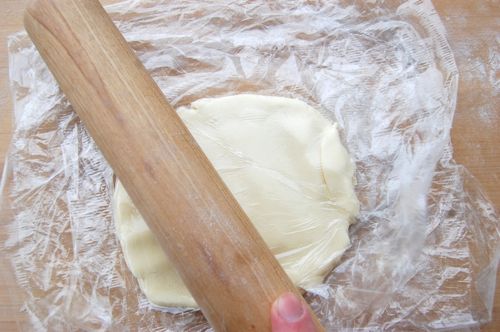
Form the pat into a rough square by pressing the edges up against the pin like so.
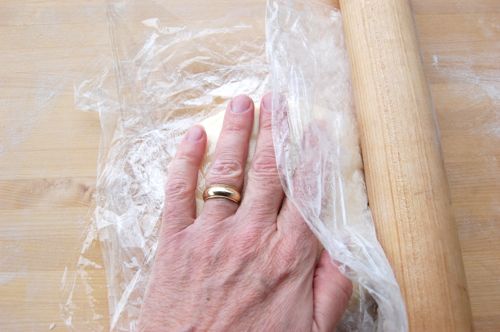
And there you have it.
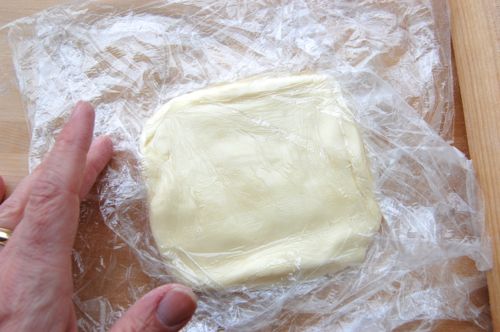
The texture should be quite plastic. Not too soft, but malleable. It’s the flour that helps the butter keep this texture while you roll it. As I mentioned earlier this week, it’s a great insulator.
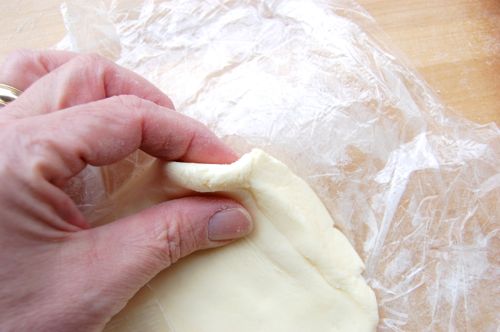
Once that’s done your dough should be ready.
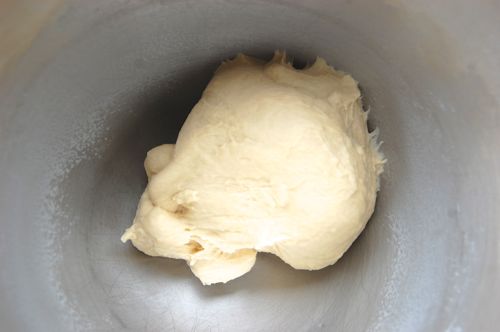
Treat it with similar brutality…bam, bam bam.
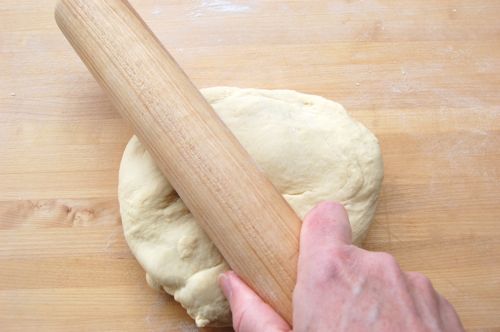
And roll it out into a roughly 9″ circle.

Promptly plop the butter pat in the center.

Pull the edges around to enclose the pat…

…squeeze the edges closed and, once again, give it a little roughing up.

Hit the packet in the center, then whack outward to drive the butter to the edges. Rotate the package a quarter turn and repeat. You should be able to feel the butter out there:
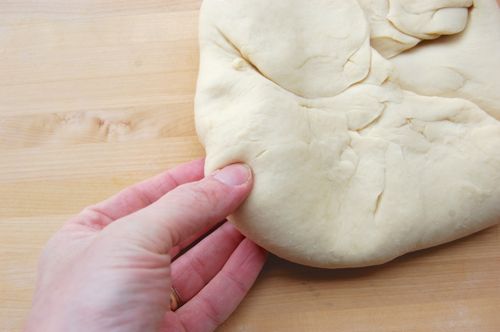
So OK. Dust the work surface lightly with flour and roll the packet out to about 10″ x 20″. A bigger pin is better here as it’ll give you more leverage…if you know what I mean.
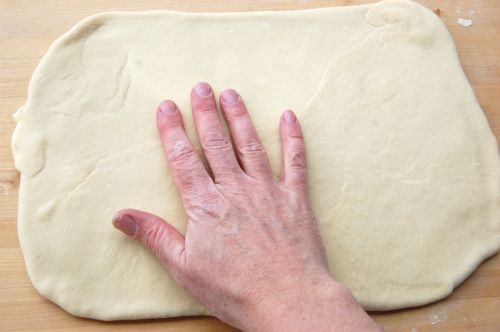
Fold in one side…

…then the other. Rest the dough in the fridge for 15 minutes, repeat the rolling folding steps, then rest the dough another 15 minutes. Or you can leave it in the fridge until you’re ready to shape and bake. It’ll keep for about 3 days.
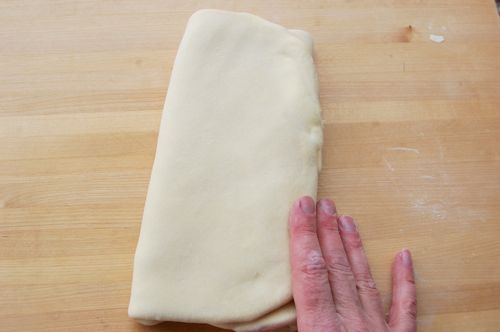
When you’re ready to shape, dust the work surface with flour and roll it to about 12″ x 24″. Again, use your biggest pin for this job. I traded up to my big, fat, 18-incher since it makes the whole rolling process easier. Check regularly to make sure the bottom isn’t sticking to the board. If so, or if some butter is protruding out, don’t fear. Apply more flour and carry on.
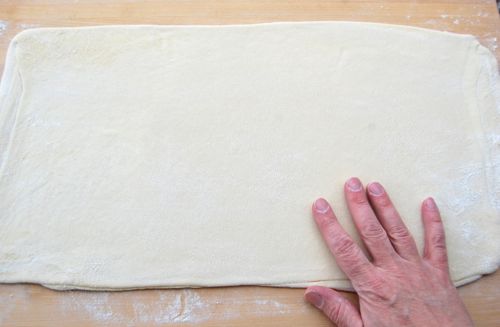
Cut it lengthwise with a pizza cutter.
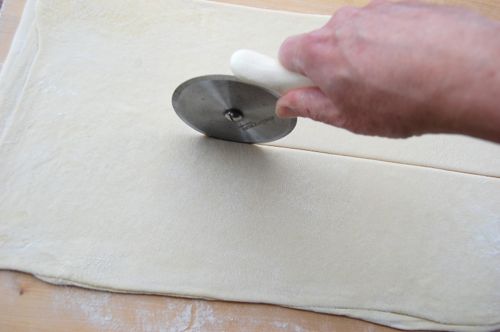
Fold up one of the pieces and put it away for later (this recipe makes 2).
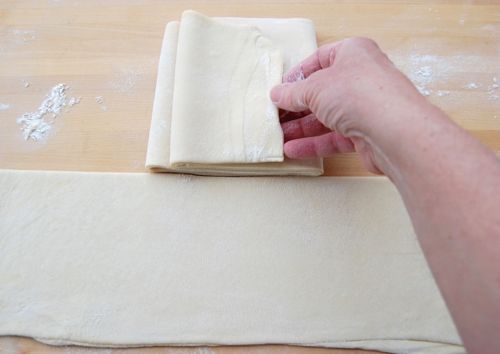
Spread your filling (in this case it’s raisin filling) on half.
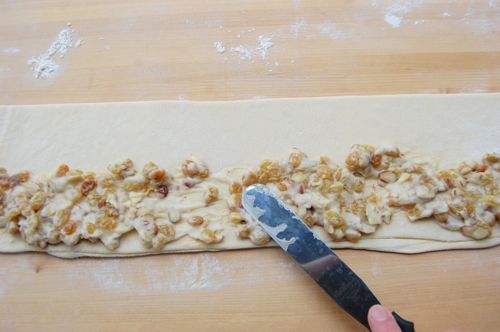
Roll the whole thing up.
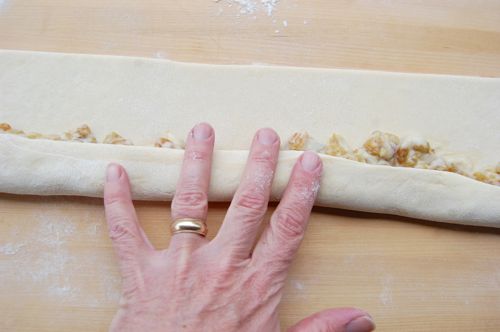
Position it seam-side down…
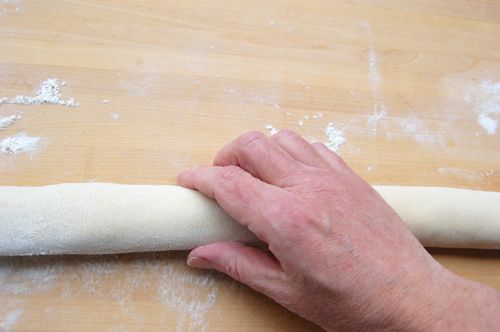
…then roll the thing with the pin. It should be about 30 inches long when you’re done.
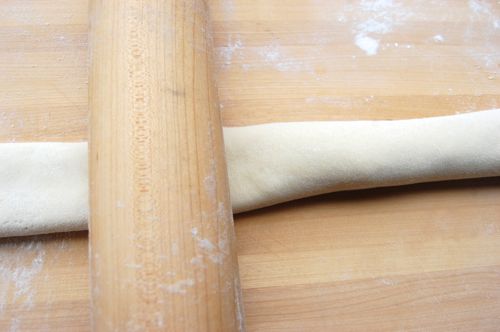
Shape that as you like — a pretzel is traditional, at least if you live in Denmark. Paint it with egg wash and let it proof for 30 minutes (50-60 if the dough was chilled prior to rolling.

After the proofing, paint more egg wash on it and sprinkle sliced almonds or streusel all over it. Bake it for 20-25 minutes until golden.

There will be some cracking. Cover the cracks with more almonds or drizzle on some icing!
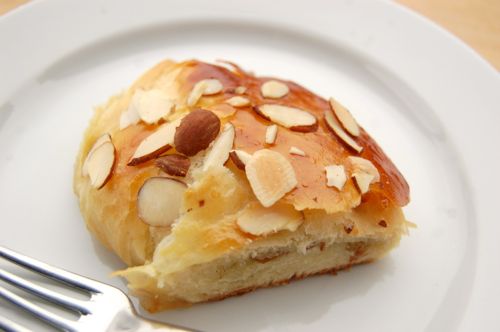
Oh yeah, that’s it: pastry the Chicago way. And while I normally don’t advocate baker-on-dough violence of the kind I showed you today, I have to say that in this case the ends justify the means.
You might want to say something about the yeast in with the flour at the beginning. The pic has it but the words don’t.
Ah yes, good thinking that.
Thank you,
– Joe
Hey Joe. I was showing my husband this incredible method for making Kringle, and when I mentioned you could fill it with options other than raisins, he immediately said, “chocolate?” There’s no chocolate option under your fillings list, but what’s your thought on getting chocolate inside a Kringle?
I’m thinking something like what’s used inside these delicious buns: http://smittenkitchen.com/blog/2012/06/chocolate-swirl-buns/
Hey Ashley! I’d suggest a coffee cake sort of treatment with a little buttercream laid down, then some chocolate chips. However this filling would work just fine, too.
Guess I need to add some chocolate to my bake-in filling section! Thanks,
– Joe
Well, I read this finale and thoroughly enjoyed it; so much so, I continued reading past entries. My niece is coming to town this weekend. (Someone help me, we’ll have her and her beau for the last week of Carnival and Mardi Gras. I may need to get ashes on her forehead before she leaves town.) It’s her birthday, and I checked the site for her favorite, coconut cake. My husband wants me to make chocolate coconut cake with some raspberry in there too. Seems a bit much?
Back to Kringles. Years ago there was a bakery near a restaurant where I worked; I believe it was Scandinavian. They had some sort of pastry which was a square puff with a sweet – cream cheese? – filling which had puffed along with the dough when it baked. Do you know if that was something with this sort of dough, or the Danish pastry? While my husband has attempted to write tonight I continuously (maybe not too obnoxiously) read entries from here to him. I do this to him, but tonight he actually enjoyed it.
Hey Naomi!
Glad you enjoyed it. And yes, I’d agree, chocolate and coconut AND raspberry would make a pretty busy cake.
Regarding the pastry, it sounds like a cheese Danish to me…but I’m not completely sure. I’ll look around on the web and see what I can find!
– Joe
The pastry you mention might be a “spandauer”, see this picture: http://da.wikipedia.org/wiki/Fil:Spandauer_med_creme.JPG
It’s a square of laminated dough with a dollop of pastry cream on top and the four corners folded in towards the middle and tucked into the cream, kind of like a little pastry parcel, then sprinkled with almond slivers and drizzled with icing. Sometimes there’s jam or fruit instead of pastry cream, but the pastry cream version is so much better 🙂
Well done, Jo. Thanks very much!
– Joe
I have not bought a mixer yet, and borrowing one seems…well, wrong. Can it be done the olde fashioned way, with plenty of elbow grease and determination? That looks like it is worth the effort!
Oh sure, Dave, not a problem. This dough is very soft and flexible. It might be a touch sticky on your hands, but not bad at all.
– Joe
Looks like the perfect tender flaky dough!
It’s really quite good I have to say. I’ll be making this a lot more int he future since it comes together a lot quicker than the coffee cakes I usually make (those rely on Danish dough and if I don’t have any in the freezer, well…let’s just say it’s time consuming!)
– Joe
That is beautiful – just beautiful. I think that after Lent I will make this. I’ve never tried a laminated dough before, and this looks like the perfect recipe to begin with. I think I’ll do a different filling though. I like raisins, but the rest of the family does not.
Do try it, Ellen, and let me know how it goes. I think you’ll be pleased with the results. And certainly do any other type of filling. Almond cream is a classic. Pastry cream and chocolate chips would be great, or even buttercream and chocolate chips if you happen to have some. Heck, plain ol’ cinnamon sugar would be delightful. Whatever catches your fancy!
– Joe
I want to try apple but will that juice up too much?
Ahh! Reconstitute dried apples and raisins together! ¯\(°_o)/¯
Neat idea! Let me know how it turns out!
– joe
Hey Dave! You can certainly do that. I’d say some chopped apples, cooked with some sugar, cinnamon and lemon juice, then pretty well reduced, would work just fine. Just apply a thin layer so it doesn’t weight the dough down.
That’s my best thought!
– Joe
I made both, one with just the raisins, one with raisins and reduced apples mixed. The mix spilled out of the Kringle roll on one end, in no way impeding the flavor, but clean-up was a hassle.
We had thirty people over this evening and both Kringles are gone. I will definitely make this one again!
Fabulous, Dave!
Pretty easy, weren’t they?
I would suggest other types of dried fruits, treated the same way as raisin filling – e.g. apricots, cranberries, prunes… Speaking of chocolate, I like filling from this recipe http://smittenkitchen.com/blog/2012/06/chocolate-swirl-buns/ it holds together well and is easy to make – guess that it will work in kringle too.
Very nice, Antuanete! Thanks!
– Joe
Hi Joe,
Thanks for preaching the kringle gospel to bakers everywhere! I’ll have to try your recipe; the texture of your pastry looks absolutely delicious. One thing you might want to try the next time you make it is to shape and bake your kringle seam-side up, so that you get a nice crispy crack running the length of your kringle, with a bit of the filling bubbling up. See photos here: http://politiken.dk/mad/ECE1199893/soeren-ryge-og-den-mest-vidunderlige-kringle-verden-har-smagt/
Best,
Jo.
Very interesting, Jo! Looks like a long strip that’s had filling spread down the center, then the edges folded in. I’ll try it with the other piece of dough I have.
And thanks it did work out really well. For tender and tasty…but neither too rich or sweet. It’s great with tea in the afternoon!
– Joe
Hi Joe, I love kringle so thanks so much for posting this! Do you have an almond cream recipe you could recommend? Thanks!
Hey Michelle!
It’s in the Fillings (bake-in) section under Pastry Components.
– Joe
Hi, Joe.
In the first picture you seem to have put the sugar and salt on one side of the flour and the yeast on the other.
Our British telly cooks tell us we must do it this way, as letting the salt come into contact with the yeast will kill the yeast. And yet once we switch the machine on the salt and the yeast are mixed together. Is this another kitchen myth?
Hi Joe
I am so enjoying your site! I am a newby to baking. I am a photographer and visuals guy by trade and have photographed some amazing food, and it’s just feeling right to create my own. My question is this: I am going to Wisconsin with family this weekend and taking a Kringle would be PERFECT! If I make the dough tonight and refrigerate it, and then bake the Kringle tomorrow night–how long will the baked Kringle stay fresh (and, well, amaze my family : ) ) I know the best would be to eat it immediately, but can I freeze the Kringle? Or should I take it with me and bake it there? Thanks Joe!
Hey Jim!
Nice to know you. These sorts of rich, sweet breads keep extremely well. 36 hours is no sweat for a kringle, so go ahead and bake it and bring it on up. A quick shot in the microwave to soften the fats and starches back up again will give it a near fresh-from-the-oven feel. Have a great trip!
– Joe
Thanks Joe…I’ll let you know how it goes…
I made this yesterday with a chocolate danish filling from Smitten Kitchen (didn’t see your filling recipe until today). I actually made the dough on Sunday and finished the final roll and filling yesterday. It retarded wonderfully in the fridge, just FYI. The dough was silky smooth and so easy to work with. Fantastic, just fantastic. My co-workers already think I’m an amazing baker but this one had them in awe. My son had to be dragged away from the Kringles before he salivated all over them. Thank you for a hit recipe!
Oh how I love a success story. Thanks so much, Anna! And congratulations!
– Joe